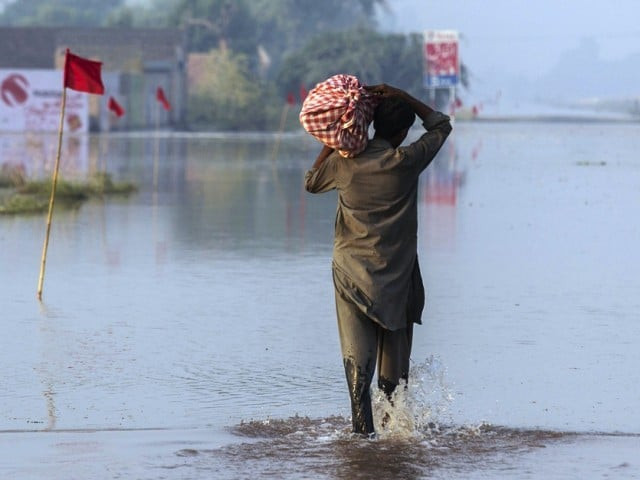Pakistan asked to turn floods into opportunities
Senate body told country is expected to face flash floods in summer

A flood victim wades through a flooded field following heavy rain in Jhang on September 11, 2014. PHOTO: AFP
The ongoing harsh weather may pose a serious threat to the wheat crop, which can impact food security in the country.
The Senate Standing Committee on Water Resources was informed by meeting participants that the country had received heavy snowfall during the winter season, therefore, it was expected that it would face flash floods in summer due to the melting of glaciers.
According to the water resources secretary, the country had suffered losses of $19 billion on account of heavy floods and rains in the past year. He warned that the country would face further loss if an amount of Rs15 billion was not allocated for a flood protection project.
As per latest reports, heavy rains and floods have damaged wheat, gram and maize crops in Punjab. The Punjab Agriculture Department is working to gauge the impact and come up with an estimate of losses in all rain-hit areas.
Govt hopes to come to farmers’ rescue
The Ministry of National Food Security and Research, however, said in a recent statement that there was no likelihood of food insecurity or emergency situation.
While reviewing the performance of Rabi crops (2018-19), the Federal Committee on Agriculture noted that wheat production was estimated as on April 7, 2019 at 25.16 million tons from an area of 8.83 million hectares. This, coupled with last year’s leftover stock, means that wheat availability is well above the total national requirement.
Pakistan has witnessed devastating floods in the past, with the one in 2010 being the worst ever in the country’s history. The flood caused over 1,985 deaths and affected 20 million people. It destroyed 17,553 villages and impacted around 160,000 sq km of land area. During the previous government of PML-N, the Council of Common Interests (CCI) approved the proposed National Flood Protection Plan-IV (2015-25) and decided that the financing for NFPP-IV would be made by the federal and provincial governments at a ratio of 50:50.
Provinces will decide their respective share of contribution amongst themselves and report to the federal government. It was decided to spend Rs332.2 billon in different phases, however, finances were a major issue in implementing the plan.
Rain turns twin cities’ streets into streams
Despite a series of floods, there seems to be no flood mitigation policy in place. In 2012, the Ramsar Advisory Mission (RAM), a group of experts under the Ramsar International Convention on Wetlands, visited Pakistan and submitted a report. They suggested a cost-effective strategy to use flood water wisely and identify wetlands for restoration. The experts identified some sites like the Lal Suhanra National Park as well as those along Guddu and Sukkur Barrages in Sindh.
They also suggested that Pakistan should study China’s Yangtze River Basin management plan developed after massive floods in 1998 that killed more than 4,000 people and resulted in an economic loss of $25 billion.
The Chinese government decided to reclaim floodplains and restore wetlands. It also decided to set up a single river water management authority.
Pakistan should also follow the Chinese model to turn floods into an opportunity. Pakistan also lacks water storages and needs more dams to store water in times of floods to save human lives and crops.
Published in The Express Tribune, April 21st, 2019.
Like Business on Facebook, follow @TribuneBiz on Twitter to stay informed and join in the conversation.



















COMMENTS
Comments are moderated and generally will be posted if they are on-topic and not abusive.
For more information, please see our Comments FAQ